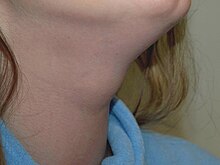Throat fistula
| Classification according to ICD-10 | |
|---|---|
| Q18.1 | Lateral neck fistula / neck cyst |
| Q18.8 | Median neck fistula / neck cyst |
| ICD-10 online (WHO version 2019) | |
Neck fistulas and neck cysts are caused by malformations in the bowels of the neck, so they are congenital. A distinction is made between median neck cysts or fistulas on the midline of the neck from lateral (lateral) or branchiogenic fistulas or cysts in the vicinity of the sternocleidomastoid muscle .
Median neck cysts or fistulas
Median cervical cysts and fistulas arise from parts of the thyroid duct that have not regressed during embryonic development . When the thyroid system descends caudally from the (later) base of the tongue , a connection to the pharynx is created, the ductus thyreoglossus. If this duct does not close completely, a median neck cyst ( Bochdalek cyst) remains. If a median neck cyst breaks out as part of an infection, a median neck fistula exists. Median cervical cysts tend to form in the area of the hyoid bone , as this is probably an obstacle to the descent. The connecting duct can lead in front of or behind the hyoid bone or pull through the hyoid bone.
Diagnosis
The median neck cyst is usually felt as a resilient swelling in the middle of the neck. It moves up and down when swallowing. 75% of cysts are diagnosed before age 6. In ultrasound a liquid-filled cavity can be seen. A median neck fistula is a small opening in the skin roughly in the middle of the neck, from which cloudy, even purulent secretion can emerge.
therapy
Due to the risk of infection with subsequent fistula formation, the cyst is usually surgically removed after the diagnosis. Any attached fistula duct with the central portion of the hyoid bone is also removed (thus recurrence rate below 5%, if left 50% recurrences). If present, the fistula duct must be traced to the foramen caecum linguae (small pit at the base of the tongue) and removed. Any existing goiter in the base of the tongue ( dystopic thyroid tissue) may only be removed if a normal thyroid can be detected by scintigraphy (otherwise a lifelong hormone intake is required). If the cyst is already infected, the infection must first be treated before the cyst is removed.
Lateral cervical cysts or fistulas
Lateral neck cysts or neck fistulas are remnants of the branchial arches or gill grooves, which is why they are also called branchiogenic neck cysts or fistulas . The gill arches arise between the 4th and 8th week of embryonic development in the area of the pharynx.
Most often a remnant of the second gill arch remains. As the neck develops, the second gill arch grows over the third and fourth. This creates a cavity, the cervical sinus , which normally disappears completely later. If this cavity does not completely recede, a passage or parts of the passage remain from the area of the tonsils through the cervical soft tissues along the carotid artery to the outside of the skin, usually in the middle to lower third of the sternocleidomastoid muscle .
Diagnosis
The lateral cervical fistula is noticeable through a small opening on the front edge of the sternocleidomastoid muscle on the side of the neck, from which milky or purulent secretion can flow. If the (congenital) duct does not have a skin opening to the outside, a resilient swelling, the lateral cervical cyst, which often reaches a size of more than 5 cm, can usually develop relatively quickly in childhood or early adulthood. It can then be felt in front of the sternocleidomastoid muscle and is usually clearly visible. Remnants of the other gill arches show up as openings or swellings on the neck, jaw or cheek. In unclear cases, radiological examinations ( CT , MRT ) can help.
therapy
Like median neck cysts, lateral neck fistulas and cysts should be operated on because of the risk of infection.
See also
swell
- P. Puri, M. Höllwarth: Pediatric Surgery . Springer, 2006, pp. 3-12.
- Rudolf Probst, Gerhard Grevers, Heinrich Iro: Ear, nose and throat medicine . 3rd, revised edition. 2008, ISBN 978-3-13-119033-8 , pp. 290-292.
- C. Brewis, M. Mahadevan, CM Bailey, DP Drake: Investigation and treatment of thyroglossal cysts in children. In: Journal of the Royal Society of Medicine. Volume 93, No. 1, 2000, pp. 18-21. PMID 10700841 .



